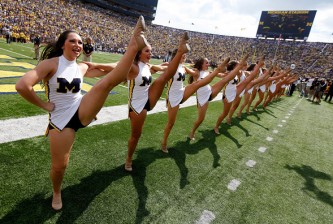This is a review of the ESPN 30 for 30 documentary, “Muhammad and Larry” on the 1980 fight between heavyweight boxing legend Muhammad Ali and his friend and one-time sparring partner, Larry Holmes.
We pick up the documentary in August 1980, two months before a 38 year old Ali is to fight then-heavyweight champion, Larry Holmes. At this time, Ali is training, hoping to once again call up the magic that helped him defeat Leon Spinks in 1978, at the Louisiana Superdome, winning the undisputed heavyweight championship for an unprecedented third time. Following that fight, he retired or so everyone thought.
But when he signed for the fight against Holmes, Ali was hoping to capture the magic once more. His long-time trainer Angelo Dundee felt trepidation. However, he said Ali had the right to go out on his own terms. And so Ali continued to train for the fight against Holmes.
We also hear from Ali’s former ringside trainer, Dr. Ferdie Pacheco who becomes the star of this documentary. The “Fight Doctor” as he was known tells us about the deterioration of Ali and the warning signs of his condition.
Over in Easton, PA, Larry Holmes trained like a man possessed, but he knew he was in a no-win situation. If he won, he beat up an old man. If he lost, everyone would say he was a paper champion, just holding the belt until Ali came back. After winning the WBC title in 1978 in a slugfest against Ken Norton, Holmes successfully defended his belt 20 times.
In fact, Holmes was quite successful in Easton, owning several homes, but because he followed Ali, he never received the respect as a champion.
One thing we notice about the footage taken by Albert and David Maysles is the weight Ali had gained during his retirement. He was having trouble taking it off and during his sparring sessions, he was taking a lot of punches. This concerned his training staff, but Ali scoffed saying he wanted to get a feel for the punches and he took plenty of shots to his kidneys. Pacheco said kidneys don’t get trained, they get worse.
Holmes trained with Ali for four years. He liked Ali, but Holmes noted that he always wanted to keep you down. He liked you as long as he remained on top and he was the man. Holmes said when he left Ali’s camp, Muhammad told him that perhaps they’ll see each other on the road. Holmes said he told Ali, “You better hope not, because you got one coming.”
One thing that was noted by Pacheco was that Ali wanted to make people laugh. Dundee said people came to the Ali camp to be entertained and he didn’t let them down with his one-liners and poems. And he was always doing card and magic tricks.
While Ali was playing at his camp, Holmes was serious. He kept to himself. Not was many people were going to his training sessions. If he played cards, no one knew about it because the media was all at Ali’s.
Pacheco says the deterioration of Ali was noticeable through the years. He was moving slower, punching slower and talking slower. His speech was slurred. Pacheco left the Ali camp in 1977 refusing to take part in any more training. Pacheco wanted Ali to retire after the Thrilla in Manila against Joe Frazier in 1975.
A roundtable of noted writers including Ali biographer Thomas Hauser, Burt Sugar and Jerry Isenberg talked about a checkup Ali had at the Mayo Clinic in Minnesota two months before the fight. Doctors noticed that Ali had trouble performing certain tasks and his short term memory recall was bad. And with this, the Nevada Boxing Commission still licensed Ali to fight and the Mayo Clinic report was never made public.
The Maysles footage from 1980 shows Ali slurring his speech and walking quite slower. You could see the progression of his current condition starting then.
The reporters said they it was hard to feel that Ali would lose because he had performed the magic so often.
Another interesting development was the fact that Ali took thyroid pills before the fight. A doctor prescribed them for the ex-champ feeling he was overweight. It did cause Ali to lose 30 pounds, but at the same time, they stripped him of his strength. Pacheco says that is like taking the wheels off an Indianapolis speedway racer and racing without tires. The pills made his kidneys work harder. Instead of taking one pill a day, he took 3. He told his staff that the pills were vitamins. Angelo Dundee said he had no idea they were thyroid pills.
One other culprit the Maysles point to is Don King. The reporters including Hauser said this was a rare fight in which the flamboyant boxing promoter financed the entire purse so it was important to him that the fight go off as planned no matter who got hurt.
Then we focus on the fight and it’s clear to everyone that Ali has nothing. Holmes wanted to knock him out early or at least have him quit, but Ali wouldn’t go down. By the 9th, it was clear that it was one-sided.
Ali was supposed to get $8 million for the fight from Don King but got shorted $1 million. After being paid an additional $50,000, Ali dropped a threatened lawsuit, but Pacheco called it a raw deal. He added that this fight for all intents and purposes buried Ali and prevented us from seeing a vibrant man live to old age. Instead, we see the results of the beatings he took after the Thrilla in Manila.
Ali actually fought one more time in December 1981 and less than three years later, he had Parkinson’s Disease.
By contrast, Larry Holmes is healthy and operates a boxing gym. But he still yearns for the respect Ali has to this day.
A powerful documentary and one story that needed to be told. In the annals of boxing, it’s a fight that has been forgotten and to see the footage captured by the Maysles in the months leading up the fight is truly precious.
An excellent film and one very worthy of seeing again. The best of the 30 for 30 series to date. DVR, tape and find every way to see this more than once.
Overall grade – A+.
Here’s a preview of “Muhammad and Larry”.






















